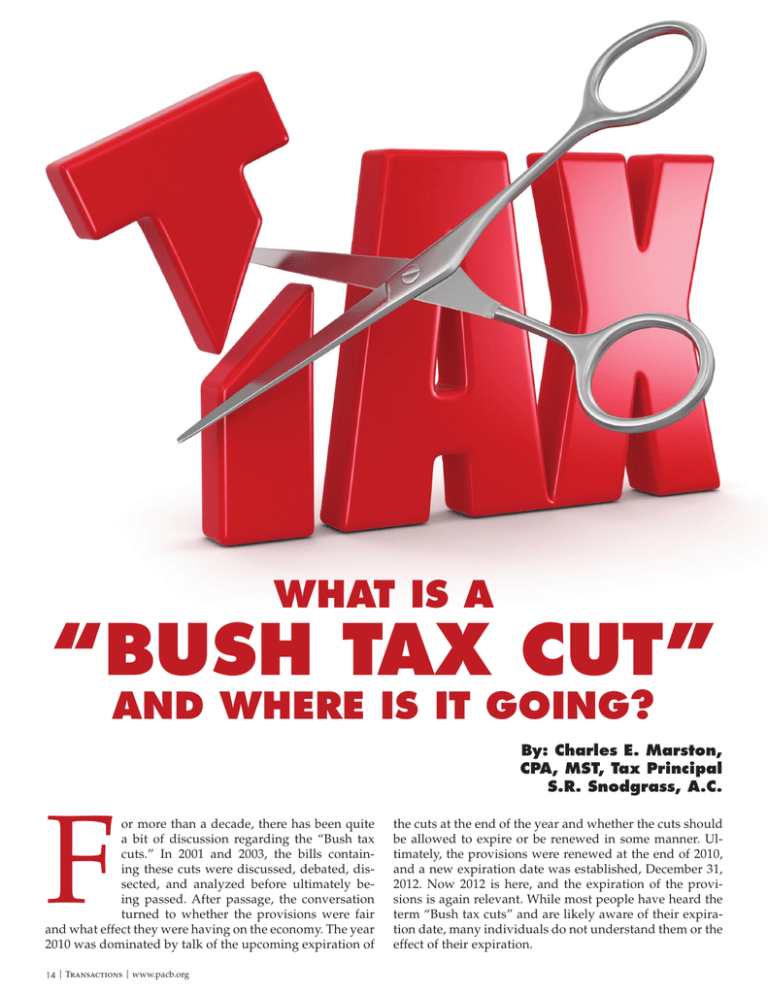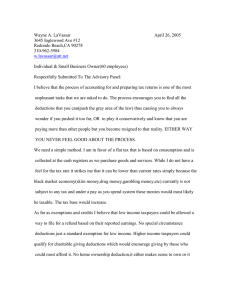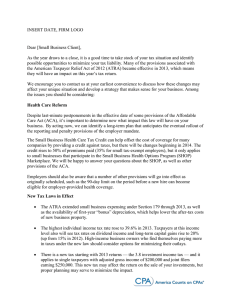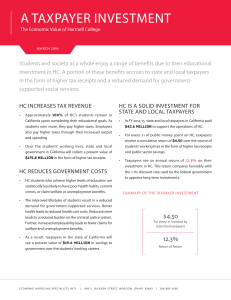BUSH TAX CUT - SR Snodgrass
advertisement

WHAT IS A “BUSH TAX CUT” AND WHERE IS IT GOING? F or more than a decade, there has been quite a bit of discussion regarding the “Bush tax cuts.” In 2001 and 2003, the bills containing these cuts were discussed, debated, dissected, and analyzed before ultimately being passed. After passage, the conversation turned to whether the provisions were fair and what effect they were having on the economy. The year 2010 was dominated by talk of the upcoming expiration of 14 | Transactions | www.pacb.org By: Charles E. Marston, CPA, MST, Tax Principal S.R. Snodgrass, A.C. the cuts at the end of the year and whether the cuts should be allowed to expire or be renewed in some manner. Ultimately, the provisions were renewed at the end of 2010, and a new expiration date was established, December 31, 2012. Now 2012 is here, and the expiration of the provisions is again relevant. While most people have heard the term “Bush tax cuts” and are likely aware of their expiration date, many individuals do not understand them or the effect of their expiration. WHAT ARE “BUSH TAX CUTS?” While commonly referred to as a single package of tax cuts, the Bush tax cuts are actually the result of two pieces of legislation passed during President George W. Bush’s first term as President. The Economic Growth and Tax Relief Reconciliation Act of 2001 (“2001 Tax Act”) and the Jobs and Growth Tax Relief Reconciliation Act of 2003 (“2003 Tax Act”) were both major legislative accomplishments for President Bush. The tax provisions included in the two Acts contained more than 30 major changes to the Tax Code and served to reduce the individual tax burden more aggressively than had been seen in years. There were not only tax rate reductions across the board but also the elimination of certain phase-outs, the expansion of popular tax credits, the elimination of components of the so-called “marriage penalty,” the taxpayer favorable overhaul of the estate/gift tax, as well as reductions to the long-term capital gain tax rate and dividend rate. In an effort to assist passage of the bills, the tax provisions carried an expiration date of December 31, 2010. In 2010, President Obama passed the Tax Relief, Unemployment Insurance Reauthorization, and Job Creation Act of 2010 (“2010 Tax Act”) which extended the life of the provisions to December 31, 2012. As things stand now, absent any action, once January 1, 2013 comes around, the Bush tax cuts will be no more. How will the expiration affect you? rate on “qualified” dividends to the lower long-term capital gain rates, with a maximum tax rate of 15%. Today, most individual taxpayers with dividend income are paying lower taxes due to this provision. After December 31, 2012, the lower rate for dividends will no longer apply, and all dividend income will go back to being taxed at normal income tax rates, which can be as high as 39.6%. This will mean a taxpayer could see a tax rate increase of more than double when it comes to his/her dividend income. HIDDEN RATE INCREASE The 2001 Tax Act phased in the elimination of two tax provisions that served to raise individual tax rates without actually increasing rates. The first provision reduced the allowable amount of itemized deductions for individuals with adjusted gross income (AGI) that exceeded a certain amount. The AGI amount, had this provision been in effect for 2012, would have been $173,650 for most taxpayers. Once the AGI limit was reached, certain deductions, such as state and local income taxes, mortgage interest, and charitable contributions, were reduced based on the taxpayer’s AGI. This “hidden” tax increase was completely eliminated as a result of the 2001 Tax Act. As of January 1, 2013, however, the limitation will be back in effect. The second hidden increase eliminated by the 2001 Tax Act It may be a long time before WE SEE ANYTHING SIMILAR AGAIN RATE CHANGES The changes that will occur after December 31, 2012 are substantial, and it is hard to imagine any taxpayer not feeling the effect of the changes in some way if the expirations occur. For starters, individual tax rates will go up. The bottom 10% tax rate, the lowest tax rate available, will disappear. The new rate structure will have two rates (36% and 39.6%) that are higher than the current maximum tax rate of 35%. The rest of the rate schedule will shuffle from a range of 15% to 33% to a range of 15% to 31%. In effect, what will happen is that all individuals will go back to the pre-2001 Tax Act days. While the rate changes will have a significant effect on higher income taxpayers, the elimination of the 10% tax rate will impact lower income taxpayers as well. Perhaps the biggest impact may occur due to changes in two tax rates that apply to specific types of income. Tax rates on long-term capital gains and qualified dividends both saw reductions under the 2003 Tax Act that will disappear after 2012. The long-term capital gain rate is scheduled to revert back to a maximum rate of 20%, up from the current 15% maximum rate. In addition, the 0% rate that is currently available to lower income taxpayers will go away. As for the tax rate on dividend income, the 2003 Tax Act tied the is the personal exemption phase-out, which decreased the allowable deduction for personal exemptions if a taxpayer’s AGI exceeded a certain amount. The AGI amount, had this provision been in effect for 2012, would have been $173,650 for single taxpayers and $260,500 for married taxpayers filing a joint return. Like the itemized deduction limitation, this phase-out has also been completely eliminated as of 2012, but once 2013 arrives, it will be back. MARRIAGE “PENALTY” Married taxpayers have historically incurred a “penalty” when compared to individual taxpayers due to how the Tax Code’s components work together. Two of these components were the tax rate schedule and the standard deduction. Prior to the 2001 Tax Act, the income level for the lowest tax rate for married taxpayers was equal to only 167% of the level for single taxpayers. Married taxpayers were also disadvantaged when it came to the standard deduction, which was also set at 167% of the amount available to single taxpayers. The 2001 Tax Act corrected these two “penalties” by setting the income level for the lowest tax rate for married taxpayers and the amount of the standard deduction available to married taxpayers to 200% of the amounts for single taxpayers. After 2012, however, www.pacb.org | Transactions | 15 married taxpayers will again feel the pain of the “marriage penalty” in these two areas, as the rules prior to the 2001 Tax Act come back into existence. POPULAR TAX CREDITS One of the most popular tax credits available to individuals will be cut in half after 2012. The child tax credit was increased to a maximum of $1,000 per qualifying child by the 2001 Tax Act. The expiration of the Bush tax cuts will see this credit reduced back to its previous maximum amount of $500 per qualifying child. In addition to increasing the amount of this credit, the 2001 Tax Act also provided beneficial adjustments to the amount of the credit that could be considered refundable and the amount of the credit that could be used to offset an individual’s alternative minimum tax (AMT). After expiration, these adjustments will no longer apply. Other popular tax credits will also see changes that are not favorable to the taxpayer after 2012. Changes include either reducing the credit amount, decreasing the amount of income levels for phase-outs, changing how a credit can be used for AMT, and/or eliminating other advantageous alterations made to the credits. The credits that will be affected include the child and dependent care credit, the adoption credit, the employer-provided child care credit, and the earned income tax credit. ESTATE TAX/GIFT TAX The maximum estate tax exemption for 2012 is $5.12 million. The estate tax rate for 2012 is 35%. These amounts, compared to the pre-Bush tax cut years, are extremely favorable to taxpayers, and are the product of the 2001 and 2003 Tax Acts. After 2012, the estate tax exemption is scheduled to revert back to $1 million and the maximum estate tax rate will increase to 55%. Gift tax rates and exemptions are scheduled to change in similar ways after 2012. OTHER DEDUCTIONS/EXCLUSIONS There are other deductions and exclusions which were either created, increased, or modified by the 2001 and 2003 Tax Acts. The expiration of these provisions after December 31, 2012 will cause adverse results for many individual taxpayers. The provisions that are scheduled to be affected include the educational assistance exclusion, Coverdell Savings Account contributions, student loan interest deductions, and parts of the small business stock exclusion. There are also several provisions that, while not included in either the 2001 or 2003 Tax Acts, were passed either as part of the 2010 Tax Act or other tax legislation, that have become associated with the Bush tax cuts, despite being passed while President Bush was out of office. These provisions are due to expire after December 31, 2012 as well. Included among these provisions are the state sales tax deduction, the teacher’s classroom expense deduction, the mortgage insurance deduction, the exclusion for charitable contributions of IRA distributions, and popular payroll tax cuts in effect the past few years. 16 | Transactions | www.pacb.org WHAT IS NEXT? All of the changes described above will occur absent some action by Congress and the President prior to January 1, 2013. While it is certainly in the realm of possibility that a deal similar to the 2010 Tax Act could be reached to save all or some of the tax cuts, it does not seem likely. With the 2012 presidential election coming in November, the possibility of a lame duck Congress, and the overall environment that exists in Washington, D.C. today, very few people are holding out hope that anything similar to the 2010 Tax Act will arrive to save the day. If the expected occurs, and most, if not all, of the Bush tax cuts expire, taxpayers should enjoy the final few months of 2012 because after that, it may be a long time before we see anything similar again. Chuck, a Tax Principal at S.R. Snodgrass, A.C., has 20 years of experience in corporate return preparation and overall tax planning. He is proficient in compliance issues and interpreting the complexities in IRS, state, and local taxing entities as they relate to the banking industry.


